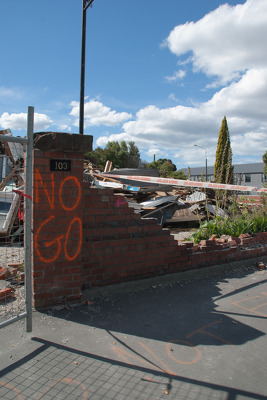
None

After the demolition - ex-Thom Autoglass building south-east corner St Asaph St and Barbadoes Street

Building rubble in front of a partially demolished house on Peterborough Street. The photographer comments, "Wood at the front, bricks in the middle and bits of house at the back".

Demolition rubble seen through the cordon fence.

Damaged buildings and demolition rubble down Tuam Street.

Looking through the cordon fence, demolition rubble in a overgrown site. A digger working on top of the rubble.

Looking through the cordon fence, demolition rubble in a overgrown site. A digger working on top of the rubble.

Looking through the cordon fence, demolition rubble in a overgrown site. A digger working on top of the rubble.

Looking through the cordon fence, demolition rubble in a overgrown site. A digger working on top of the rubble.

A page banner promoting an article about demolition rubble dumped by Skelly Holdings.

A digitally manipulated image of building rubble.

Demolition sites and rubble across from Latimer Square, near the corner of Hereford Street.

Demolition sites and rubble across from Latimer Square, near the corner of Hereford Street.

Demolition sites and rubble across from Latimer Square, near the corner of Hereford Street.

A graphic describing a proposal to use demolition rubble for land reclamation in Lyttelton.

The backs of damage bulidings on High Street and demolition rubble seen from Tuam Street.

Demolition rubble and furniture on a site at the corner of Armagh and Durham Street.

A demolition site with the words "No Go" spray painted on a fence that has been mostly demolished. Demolition rubble is still contained within the grounds.

A pile of demolition rubble on Gloucester Street. The site was formerly that of the Brannigans building.

A pile of demolition rubble on Gloucester Street. The site was formerly that of the Brannigans building.

A black and white photograph of a steel structure on a demolition site filled with building rubble.

A digitally manipulated photograph of twisted reinforcing rods amongst the rubble from the demolition of QEII. The photographer comments, "These rarely seen worms live in the pressurised earth under the foundations of buildings. They need a damp soil and be under at least 100 pounds of pressure per square inch. After the destructive force of an earthquake they swiftly rise to the surface through gaps in the rubble. Unfortunately they quickly die and then crystallise as hard as iron in the dry low pressure air".

Deconstruction of office buildings next to the COCA gallery. In front of the buildings are piles of demolition rubble.

Demolition rubble next to a house where the walls have crumbled. The wall has been covered by a tarpaulin.

A photograph of the rubble from a demolished building on the corner of Main North and Harewood Roads. Wire fencing has been placed around the building as a cordon.

A photograph of the rubble from a demolished building on the corner of Main North and Harewood Roads. Wire fencing has been placed around the building as a cordon.

A demolition site with the words "No Go" spray painted on a fence that has been mostly demolished. Demolition rubble is still contained within the grounds. A portaloo can be seen on the footpath.

A demolition site where loose cables hang from the roof. Construction workers and a digger can be seen behind the rubble.

A demolition site where loose cables hang from the roof. Construction workers and a digger can be seen behind the rubble.

Detail of some deconstruction work on the Crowne Plaza Hotel, close up with a digger on a pile of demolition rubble.
